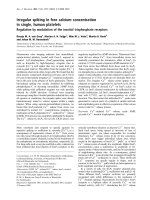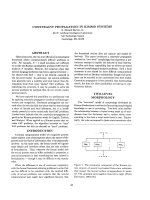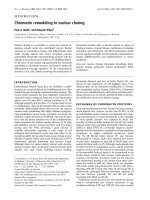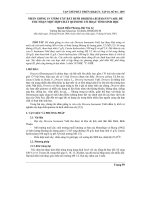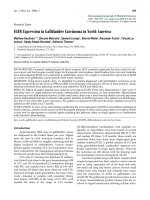Báo cáo y học: "Prion propagation in vitro: are we there yet"
Bạn đang xem bản rút gọn của tài liệu. Xem và tải ngay bản đầy đủ của tài liệu tại đây (264.09 KB, 7 trang )
Int. J. Med. Sci. 2008, 5
347
International Journal of Medical Sciences
ISSN 1449-1907 www.medsci.org 2008 5(6):347-353
© Ivyspring International Publisher. All rights reserved
Review
Prion propagation in vitro: are we there yet?
Chongsuk Ryou
and Charles E. Mays
Sanders Brown Center on Aging and Department of Microbiology, Immunology & Molecular Genetics, University of Ken-
tucky College of Medicine, Lexington, KY, U.S.A.
Correspondence to: Dr. Chongsuk Ryou, 800 Rose St. HSRB-326, Lexington, KY 40536. Phone: (859) 257 4016; Fax: (859) 257 8382;
E-mail:
Received: 2008.11.03; Accepted: 2008.11.10; Published: 2008.11.11
Prion diseases are caused by proteinaceous pathogens termed prions. Although the details of the mechanism of
prion propagation are not fully understood, conformational conversion of cellular prion protein (PrP
C
) to mis-
folded, disease-associated scrapie prion protein (PrP
Sc
) is considered the essential biochemical event for prion
replication. Currently, studying prion replication in vitro is difficult due to the lack of a system which fully reca-
pitulates the in vivo phenomenon. Over the last 15 years, a number of in vitro systems supporting PrP
C
conver-
sion, PrP
Sc
amplification, or amyloid fibril formation have been established. In this review, we describe the
evolving methodology of in vitro prion propagation assays and discuss their ability in reflecting prion propaga-
tion in vivo.
Key words: prion disease, prion, cellular prion protein, disease-associated scrapie prion protein, in vitro conversion, in vitro
prion amplification, prion infectivity
Introduction
Prion diseases, also known as transmissible
spongiform encephalopathies, are fatal neurodegen-
erative disorders including Creutzfeldt-Jakob disease
in humans, scrapie in sheep, chronic wasting disease
in cervids, and bovine spongiform encephalopathy in
cattle. The only known component of the infectious
prion particle is the disease-associated isoform of the
prion protein designated PrP
Sc
.
1
PrP
Sc
replication is
facilitated in a nucleic acid free manner, in which the
causative agent functions as a template to convert the
normal cellular prion protein, PrP
C
, into its infectious
isoform.
2
The conversion process appears to be trig-
gered by interaction of PrP
Sc
with PrP
C
.
3
When PrP
C
is
converted to PrP
Sc
, it undergoes a major biochemical
alteration from an α-helical to a ß-sheet conforma-
tion.
3,4
PrP
C
is easily hydrolyzed by proteinase K (PK)
digestion, while similar treatment on PrP
Sc
leaves a
PK-resistant core termed PrP27-30.
Conversion of PrP
C
to PrP
Sc
has been successfully
reproduced in cell-based and animal systems in which
PrP
Sc
was propagated and prion infectivity was main-
tained.
5,6
Several in vitro conversion assays have been
introduced over the past 15 years to investigate how
PrP
C
is conformationally altered by PrP
Sc
. However,
molecular conversion in various cell-free systems
failed to completely reproduce the proposed prion
conversion process. Although close, none of the in vi-
tro systems perfectly simulate prion propagation. Con-
version of PrP
C
to PrP
Sc
seems to be difficult in most
cell-free reactions unless many other molecules be-
sides PrP isoforms were also present.
The continuous evolution of in vitro assays mim-
icking the conditions of prion conversion and propa-
gation is under progress. In the following sections, we
attempt to review all of the in vitro conversion assay
systems available in an unbiased manner and discuss
how they have contributed in answering the impor-
tant questions in the field of prion biology. The de-
tailed conditions utilized in each methodology are
summarized in Table 1.
Initial Development of In Vitro Conversion
The initial development of an assay to reconsti-
tute the PrP conversion process in vitro began in
Prusiner’s laboratory.
7
Prusiner and colleagues at-
tempted to convert chimeric mouse/hamster MHM2
PrP expressed in N2a cells or metabolically labeled
PrP
C
of ScN2a cells in the presence of either exoge-
nous or endogenous PrP
Sc
by incubating overnight.
They also attempted to convert Syrian hamster (SHa)
PrP
C
synthesized by cell-free translation systems sup-
plemented with microsomal membranes prepared
Int. J. Med. Sci. 2008, 5
348
from scrapie-infected SHa brain cells. Despite the
novel idea behind these approaches, protease-resistant
MHM2 PrP (PrP-res), radio-labeled PrP-res, and
SHaPrP-res were not formed by the assays. Even
though all experiments gave negative results, it is ap-
parent that these experimental processes sparked
ideas that would soon lead to the establishment of a
successful in vitro conversion assay.
Table 1. Summary of in vitro assays for PrP
C
conversion and
PrP-res formation.
†
The buffer system has been improved for the recent studies in
which buffer containing 1 M GdnHCl, 2.4 M urea, and 150 mM
NaCl, pH5.0-6.8 was used
37-39
.
‡
NaOAc: sodium acetate.
Cell-Free Conversion Assay
A milestone was reached by Caughey and col-
leagues when the first PrP-res was formed in an in
vitro assay termed cell-free conversion.
8
This method
utilized guanidine hydrochloride (GdnHCl)-treated
PrP
Sc
purified from prion-infected brains and ra-
dio-labeled PrP
C
derived from mouse fibroblast cells.
When a large excess of PrP
Sc
was incubated with small
amounts of PrP
C
, autoradiography of the PK-digested
sample indicated that 10-20% [
35
S]-PrP
C
was converted
into [
35
S]-PrP-res.
9,10,11
Although slowly becoming
out-dated with the introduction of more modern tech-
niques, the cell-free conversion assay has become the
best characterized in vitro conversion system available,
and it has been modified on multiple occasions to bet-
ter answer different questions associated with the
molecular mechanism of PrP
Sc
replication.
Caughey’s group made two major modifications
for the cell-free conversion assay. First, GdnHCl was
substituted with either KCl or NaCl to generate ra-
dio-labeled PrP-res under more physiological condi-
tions. A number of studies preferentially chose KCl
over NaCl under GdnHCl-free conditions, implicating
KCl may be more suitable.
10,12,13,14,15
Although suc-
cessful, the overall efficiency of the reaction under
these conditions was reduced 25-50% in comparison to
reactions containing GdnHCl.
16
The second major
Conversion
Method
Conversion Buffer Incuba-
tion
Sonica-
tion/
Agitation
PrP
C
Source PrP
Sc
Source Percent Con-
verted/
Amplified
Infec-
tivity
Refer-
ence
Mixing PBS with protease inhibi-
tors
37°C
≤ 24 hr
Lysate of N2a cells
expressing MHM2
PrP
C
PrP27-30 purified
from
prion-infected
mouse brains
0%
7
Metabolic Ra-
diolabeling
PBS with protease inhibi-
tors
37°C
≤ 24 hr
Lysate of ScN2a cells
expressing [
35
S]-PrP
C
Endogenous PrP
Sc
of ScN2a cells
0%
7
Microsomal
Membranes
20 mM Tris buffer, pH 7.5 25°C
1 hr
[
35
S]-PrP
C
synthe-
sized by cell-free
translation systems
Microsomal mem-
branes from
scrapie-infected
hamster brain cells.
0%
7
Cell-Free Con-
version
0.75 M GdnHCl, 130 mM
NaCl, 10 mM Tris-HCl, pH
7.0
20°C
22 hr
[
35
S]-PrP
C
expressed
in mouse fibroblast
cells
Brain-derived
PrP
Sc
treated with 2
-3 M GdnHCl for 5
h at 37°C
10-20% of PrP
C
converted
No
8
Cell-Lysate
Conversion
50 mM Tris, pH 7.4, 150
mM NaCl, 0.5% Triton
X-100, 0.5%SDS
37˚C
48 hr
Lysate of CHO cells
expressing MHM2
PrP
C
Brain-derived
mouse PrP
Sc
Successful, not
quantified
24
PMCA PBS with 0.05% Triton
X-100, 0.05% SDS, protease
inhibitors
37˚C
10-72 hr
40 sec soni-
cation
Normal, uninfected
crude brain ho-
mogenate
Prion-infected
crude brain ho-
mogenate
~ 20 -100 fold
increase of PrP
Sc
Yes
26, 27
PMCA under
non-denaturing
conditions
PBS with 1% Triton-X 100,
0.5 mM EDTA
37˚C
16-48 hr
Continuous
agitation,
800 rpm
Purified brain
-derived PrP
C
PrP27-30 ~10-fold increase
of PrP
Sc
Yes
29, 30
rPrP-PMCA PBS with 0.05-0.1% SDS,
0.05-0.1% Triton X-100
37˚C
24 hr
40 sec soni-
cation
rPrP
C
expressed in
E.coli
Purified PrP
Sc
or
crude homogenate
of prion-infected
brains
~10% of rPrP
C
converted; fold
increase of PrP
Sc
not quantified
34
QUIC PBS with 0.05% SDS, 0.05%
Triton X-100
45˚C
46 hr
10 sec agi-
tation,
every 2 min
rPrP
C
expressed in
E.coli
Prion-infected
crude brain ho-
mogenate
Variable, sensi-
tive to environ-
mental condi-
tions
35
β-oligomer : sequential
dilution with 5 M urea, 20
mM NaOAc
‡
, 0.2 M NaCl,
pH 3.7, and with 1 M urea,
20 mM NaOAc, 0.2 M
NaCl, pH 5.5
20˚C
16 hr
rPrP
C
expressed in
E.coli
None
36
Autocatalytic
Conversion
Assay
amyloid fibril : identical
buffer to generate
β-oligomer
†
37˚C
10-72 hr
Continuous
agitation,
600 - 900
rpm
rPrP
C
expressed in
E.coli
None Yes
38, 40
Int. J. Med. Sci. 2008, 5
349
modification was the establishment of the solid-phase
cell-free conversion assay using non-isotopic material
such as biotinylated PrP
C
.
17,18,19
This format incorpo-
rates a 96-well plate for high-throughput conversion.
17
Following the attachment of the partially purified
PrP
Sc
or scrapie-positive microsomes on the plate sur-
face, conversion of PrP
C
was carried out with or
without GdnHCl treatment over a period extended up
to 48 hr. Enzyme-conjugated avidin allowed bioti-
nylated PrP-res to be detected by either Western blot
analysis or directly on the plate in an ELISA-like fash-
ion.
17
Scrapie-positive microsomes converted ~20% of
PrP
C
into PrP-res conformation, while only ~10% of
PrP
C
was converted into PrP-res with partially puri-
fied PrP
Sc
. These achievements were successful in cre-
ating an environment for cell-free conversion that was
more similar to physiological conditions and more
applicable to rapidly screen large numbers of com-
pounds inhibiting both binding and conversion.
17,18,19
Other groups have attempted to replace the PrP
C
substrate purified from mammalian cells with the
protein generated by baculovirus-infected insect cells
or bacteria in cell-free conversion.
20,21,22
Iniguez et al.
was able to convert radio-labeled PrP
C
expressed in
insect cells to PrP-res via the GdnHCl method.
21
Kirby
et al. demonstrated that, upon incubation with par-
tially purified PrP
Sc
, the bacterially expressed and re-
folded [
35
S]-PrP
C
was successfully converted into
PrP-res under GdnHCl-free conditions.
22
Similarly,
Eiden et al. generated PrP-res after slightly modifying
the conditions to eliminate the use of radio-active ma-
terial by utilizing L42 epitope (W144Y)-tagged PrP
C
expressed in E. coli.
20
Since these PrP
C
substrates were
generated in non-mammalian cells, post-translational
modification states of these proteins were not identical
to native PrP
C
. Despite the glycosylation differences,
conversion efficiency was not significantly altered
from the original assay, suggesting that
post-translational modification did not appear to in-
fluence conversion efficiency under these experimen-
tal conditions.
Cell-free conversion has several limitations even
after the improvements described above. In this sys-
tem, the concentration of the PrP
Sc
seed must be
50-fold higher than PrP
C
to obtain the formation of
PrP-res.
8
Although cell-free conversion simulates sev-
eral critical aspects of in vivo replication, unrealistic
stoichiometry between PrP
C
and PrP
Sc
indicated that
conversion in this system did not reflect the continu-
ous PrP
Sc
formation in vivo.
15
Furthermore, PrP-res
generated by cell-free conversion was inadequate to
transmit the disease in bioassay. Although cell-free
conversion initiated by hamster-adapted scrapie Sc237
prions converted the chimeric mouse/hamster MH2M
PrP
C
into PrP-res, this product did not cause disease in
> 550 days after challenging transgenic mice express-
ing MH2M PrP
C
. This argues that the acquisition of
protease resistance in vitro was not sufficient for the
propagation of infectivity.
23
Cell-Lysate Conversion Assay
Saborio et al. introduced a system termed the
cell-lysate conversion assay.
24
This method describes
incubating lysate of Chinese hamster ovary cells
over-expressing MHM2 PrP
C
with a 10-fold molar ex-
cess of PrP27-30, which is only one-fifth of the molar
excess of PrP
Sc
required for the cell-free conversion
assay. Interestingly, conversion was unsuccessful with
purified MHM2 PrP
C
that was incubated with a
10-fold molar excess of PrP27-30; however, the addi-
tion of PrP
C
-depleted cell lysate recovered the produc-
tion of MHM2 PrP-res. This result supports the hy-
pothesis that some unidentified factors available in the
lysate play a role in the conversion process. Although
the molar excess of PrP
Sc
required was significantly
decreased, this system still has similar problems as
those described for cell-free conversion.
Protein Misfolding Cyclic Amplification
(PMCA)
Soto and colleagues established PMCA that util-
izes cyclic bursts of sonication to convert PrP
C
into a
protease-resistant, infectious PrP
Sc
-like product under
a stoichiometric condition in which PrP
C
is in excess.
25
This system was composed of a mixture of
prion-infected brain homogenate (IBH) diluted in a
>1000 fold excess of normal, uninfected brain ho-
mogenate (NBH). Each PMCA cycle allowed amplifi-
cation of PrP
Sc
during the 1 hr incubation at 37˚C and
disruption of aggregated PrP
Sc
by five 1 sec sonication
pulses. Incubation facilitated conversion and aggrega-
tion of PrP isoforms, while sonication multiplied the
number of small aggregates available to induce PrP
Sc
conversion. Analysis of the samples that underwent 0,
5, 10, 20, or 40 PMCA cycles demonstrated that the
amount of newly generated PrP
Sc
was directly propor-
tional to the number of cycles conducted. The newly
formed PrP
Sc
constituted > 95% of total PrP
Sc
after 5
amplification cycles.
25
A major change in PMCA was achieved by the
incorporation of a programmable sonicator and a
96-well plate format, which enabled high through-put
assays.
26
In this PMCA, each round consisted of 20
cycles with a 40 sec sonication every 30 min. Upon
completion of each round, a small aliquot of the am-
plified samples were taken and diluted 10-1000-fold
into fresh NBH to carry out the subsequent rounds of
PMCA. Serial PMCA was shown to be continued suc-
Int. J. Med. Sci. 2008, 5
350
cessfully even after the original PrP
Sc
seeds were di-
luted up to 10
55
–fold. This suggests that PrP
Sc
could
be replicated infinitely in vitro. Furthermore, the
products of serial PMCA preserved characteristics of
the original PrP
Sc
seed such as electrophoretic mobil-
ity, glycosylation pattern, amino acid composition, PK
resistance, Fourier transform infrared spectroscopy
profile, electron microscopy profile, heat-resistance
profile, and resistance to denaturation by GdnHCl.
More importantly, unlike previous in vitro con-
version methods, the PrP
Sc
generated by PMCA was
found to be infectious. When serial PMCA products
were inoculated, animals succumbed to disease. It
appears that infectivity of serial PMCA was due to
newly synthesized PrP
Sc
since the original PrP
Sc
seeds
were diluted beyond the minimum infectious level.
Although infectious, the in vitro generated PrP
Sc
product exhibited longer incubation periods in ani-
mals than an equal amount of brain-derived PrP
Sc
.
This suggests that PMCA is less robust in generating
infectious prion particles than in vivo systems. None-
theless, prion strain properties of brain-derived PrP
Sc
appeared to be conserved in the PMCA product by
exhibiting indistinguishable clinical signs and vacuo-
lation pattern. In addition, the pathogenecity of in vi-
tro generated PrP
Sc
appeared to be stable upon serial
transmission.
27
The PMCA assay has a strong up-side, but it still
has a few drawbacks. The success of PMCA was spe-
cifically influenced by the prion strains and the PrP
C
substrate, which requires optimization of ultrasound
strength and length of sonication in a case by case
manner for maximum amplification.
28
Similar to the
cell-lysate conversion assay, PMCA appears to require
the presence of unknown factors available in the brain
homogenate. Inferiority of PMCA-generated prion
particle to its natural counterpart in transmitting dis-
ease may be hindered by sonication and the presence
of detergents, which might denature cellular protein
factors or disrupt the native mechanism for the in vivo
conversion of PrP
C
to PrP
Sc
. However, problems asso-
ciated with this assay seem relatively minor in com-
parison to the previous methods described for in vitro
conversion.
PMCA under Non-Denaturing Conditions
Supattapone modified the PMCA technique by
omitting the use of sonication and anionic detergent
sodium dodecyl sulfate because either process could
potentially denature cellular protein factors and alter
the normal biochemical reactions required for conver-
sion in vivo.
29
This assay was performed with 1:50 di-
lution of 10% (w/v) IBH into NBH. A conversion re-
action incubated for 16 hr at 37˚C with continuous
shaking produced ~6-fold increase in PrP-res com-
pared to the PrP
Sc
seed, while incubation for > 48 hr
under the same conditions produced > 10-fold in-
crease in PrP-res.
29
Generation of PrP-res was also de-
pendent on temperature as more products were de-
tected in the assay conducted at 37˚C in comparison to
25˚C and 4˚C. The introduction of the non-denaturing
method was significant because fundamental proper-
ties of PrP
Sc
formation involved in cellular cofactors
could be studied, which was not permitted with the
method described by Soto’s group.
The improvement made to this PMCA method
was to remove the additional factors present in the
brain homogenate. This version of modified PMCA
utilized PrP27-30 as seeds to convert mature, mam-
malian PrP
C
partially purified from brain homogenate
by detergent solubilization along with immunopurifi-
cation. Continuous shaking of the mixture of PrP27-30
and PrP
C
molecules at a molar ratio of 1:250 yielded
~2-fold PrP-res amplification. Supplementation of
polyanionic compounds such as synthetic poly A
+
RNA in this reaction dramatically increased PrP-res
formation to ~ 10-fold, which are levels equivalent to
those obtained with the crude brain homogenate.
30,31
Interestingly, even more vigorous PrP-res formation
was achieved if sonication was applied to the proto-
col.
30
In addition, the PrP-res product generated from
this modified version of PMCA under non-denaturing
conditions has been indicated to be infectious; how-
ever, the in vivo study has not been described in en-
tirety.
31
Because this protocol uses purified PrP
C
and
PrP
Sc
for conversion, it may represent one the most
effective assays for identifying co-factors that play a
role in PrP
Sc
propagation.
On the basis of earlier success,
30
Supattapone’s
group recently applied a periodic sonication, instead
of continuous agitation, to their modified PMCA to
increase the conversion rate. Suggesting its essential
role in this revised method, no periodic sonication
resulted in failure of PrP-res formation. Under this
condition, incubation of PrP27-30 and PrP
C
highly pu-
rified by a combination of several chromatographic
steps along with synthetic poly A
+
RNA molecules
resulted in efficient PrP-res formation.
32,33
Surpris-
ingly, even in the absence of PrP27-30 seeds, purified
PrP
C
supplemented with synthetic poly A
+
RNA
propagated PrP-res, implicating de novo generation of
PrP
Sc
.
32
Similar to seeded PMCA products, de novo
generated PrP
Sc
was infectious when inoculated into
animals and exhibited almost equivalent infectivity,
neuropathological characteristics, and clinical symp-
toms to natural prions found in the diseased brain.
32
This method of PMCA has the most simplistic re-
quirements for the formation of infectious PrP
Sc
.
Int. J. Med. Sci. 2008, 5
351
Recombinant PMCA and Quaking-Induced
Conversion (QUIC)
Caughey and colleagues recently reported a pro-
tocol that uses recombinant (r) PrP as a substrate to
amplify PrP-res in PMCA, which is referred to as
rPrP-PMCA.
34
This method slightly modified the con-
ditions of conventional PMCA established by Soto and
colleagues. The modification includes an incubation
disrupted by less frequent sonication over a period of
24 hr. When rPrP prepared from transformed E. coli
was seeded by either crude homogenate or purified
PrP
Sc
derived from prion-infected brains, rPrP-PMCA
allowed amplification of rPrP-res. This product was
distinguishable from the other species of rPrP-res
spontaneously formed by rPrP self-aggregation due to
the molecular size differences. Complication with
spontaneous rPrP self-aggregation can be avoided by
addition of Triton X-100. The optimized rPrP-PMCA
demonstrated a sensitive ability to convert rPrP to
rPrP-res only with a minute amount of (ag –fg) PrP
Sc
seeds. In fact, two rounds of PMCA using this proto-
col were sufficient to amplify PrP
Sc
from the cerebral
spinal fluid of animals at the terminal stage of prion
disease. This system eliminates the involvement of
brain homogenate-associated factors while allowing
incorporation of diversely manipulated PrP substrate.
The QUIC assay was derived from the
rPrP-PMCA procedure.
35
QUIC exchanged the use of
sonication with automated tube shaking to induce the
conversion of rPrP
C
to PrP-res. QUIC was able to de-
tect prions at a sensitivity level similar to rPrP-PMCA.
QUIC has several advantages over conventional
PMCA with its speed, sensitivity, simplicity, and ease
of duplication. However, rPrP-res generated from
rPrP-PMCA or QUIC have not been tested in vivo for
infectivity.
Autocatalytic Conversion Assay
Baskakov developed a novel in vitro system re-
ferred to as the autocatalytic conversion assay. The
principle of this assay heavily relies on selective re-
folding of denatured rPrP in the absence of PrP
Sc
. In
essence, rPrP denatured by urea or GdnHCl was di-
rected to induce two types of β-sheet-rich, non-native
PrP molecules designated β-oligomers and amyloid
fibrils.
36,37,38
The β-oligomers generated by the auto-
catalytic conversion procedure retained resistance to
PK treatment. Interestingly, the β-oligomers could be
converted into an amyloid fibril by further incubation
with continuous shaking.
36,38
However, amyloid fibril
formation did not require preformed β-oligomers but
could be independently generated by continuous
shaking under identical conditions in which
β-oligomers were formed.
37,38
The rate of amyloid fibril formation was moni-
tored by thioflavin T (ThT) fluorescence, which dem-
onstrated that conversion rate was dependent on
many parameters. Amyloid fibril formation was more
rapid in neutral pH in which short fibrils similar to
prion rods were formed, while an acidic pH favored
the formation of long fibrils with distinct coil mor-
phology.
38
In addition, amyloid fibril formation was
delayed in the presence of higher concentrations of
urea. Furthermore, providing evidence as being an
autocatalytic process, the lag phase for amyloid fibril
formation was significantly reduced by seeding with
small amounts of pre-folded amyloid fibril.
36,37
An improvement for the autocatalytic conversion
assay was the introduction of the semi-automation.
37,39
The semi-automated assay incorporated the use of the
GdnHCl-based method to convert full-length rPrP
encompassing residues 23-230 into amyloid fibrils by
incubating in a 96-well plate with continuous agita-
tion. Combining the ThT fluorescence assay to this
system allowed a microplate reader to monitor the
amyloid fibril formation in real time. This
semi-automated assay was particularly useful in
studying kinetics of amyloid fibril conversion and
screening potential anti-prion drugs in a
high-throughput format.
The autocatalytic conversion assay has several
advantages over a majority of the other in vitro con-
version techniques. A major benefit is the complete
removal of cellular factors that may be introduced into
the reaction along with any kind of PrP
C
substrates or
PrP
Sc
seeds derived from the biological material de-
spite the level of purification. The autocatalytic induc-
tion of PrP
C
conversion in a reaction originally devoid
of PrP
Sc
makes this system more relevant to the in vivo
setting representing sporadic prion diseases. In addi-
tion, unlike rPrP-PMCA or QUIC, the disulfide bond
remains intact to create a non-reduced form of recom-
binant protein for conversion, which mimics the na-
tive states of a disulfide bridge in PrP
Sc
and PrP
C
molecules in vivo.
36
Although this method was reported as produc-
ing infectious amyloid fibrils, infectivity remained the
most controversial characteristic of the amyloid fibrils
generated by this assay. Prusiner and colleagues in-
duced amyloid fibrils from recombinant mouse PrP
89-230 and used these synthetic prions to infect trans-
genic animals overexpressing mouse PrP 89-230.
40
These animals developed clinical symptoms and neu-
ropathology of disease following lengthy incubation
periods. However, synthetic prions were not able to
transmit disease directly to wild type mice. To obtain
infectivity in wild type mice, synthetic prions were



